How can I maintain a healthy population of frogs and toads year-round?
Essential tips for amphibian care
Frogs and toads are amazing garden helpers. They eat pests and add a fun touch to any yard. I’ve found that keeping them around all year takes some work, but it’s worth it.

To maintain a healthy frog and toad population year-round, create a frog-friendly backyard with water features, native plants, and safe spaces. I’ve learned that adding a small pond or even a ground-level birdbath can make a big difference. These spots give frogs and toads places to lay eggs and stay cool.
I also make sure to avoid using chemicals in my yard. This keeps the frogs, toads, and their food sources safe. By taking these steps, I’ve seen more of these helpful amphibians in my garden each year.
Key Takeaways
- Create water features and plant native vegetation to attract frogs and toads
- Avoid using chemicals in your yard to keep amphibians safe
- Monitor and protect local frog and toad populations to support their long-term survival
Understanding Frog and Toad Biology
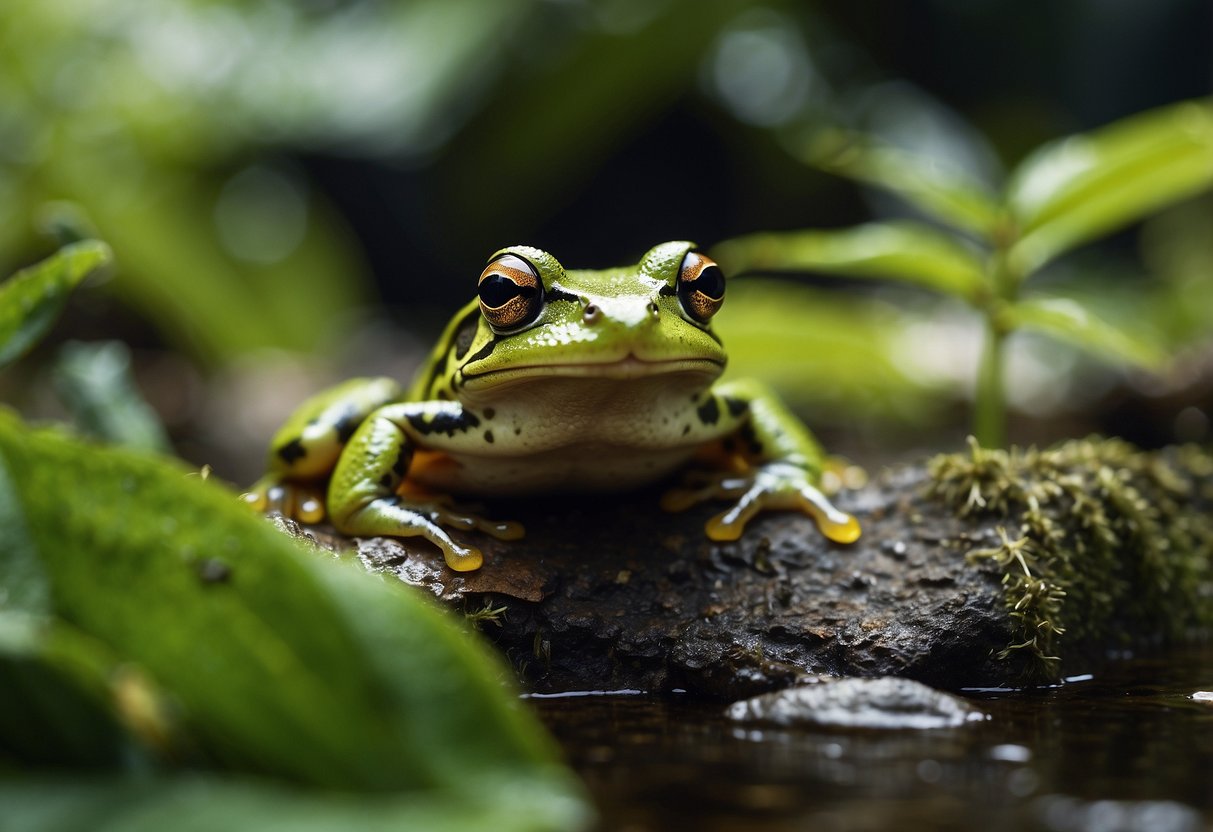
Frogs and toads have unique biological traits that affect their survival and growth. I’ll cover their life cycles, what they eat, and common health problems.
Life Cycle and Breeding Habits
Frogs and toads start life as eggs in water. The eggs hatch into tadpoles with gills and tails. Over time, they grow legs and lose their tails. This process is called metamorphosis.
Adult frogs and toads return to water to breed. Males call to attract females. Females lay eggs, which males fertilize externally.
Breeding seasons vary by species. Some breed once a year, others multiple times. Weather and habitat conditions can affect breeding success.
To help frogs and toads breed, I provide clean water sources. I also ensure there are plants near the water for shelter and egg-laying.
Dietary Requirements
Frogs and toads are carnivores. They eat insects, worms, and small animals. Their diet changes as they grow from tadpoles to adults.
Tadpoles mainly eat algae and plants. As they develop, they start eating small insects and crustaceans.
Adult frogs and toads eat:
- Flies
- Mosquitoes
- Beetles
- Worms
- Small fish (for some larger species)
I avoid using pesticides in my yard. This helps maintain a healthy insect population for frogs and toads to eat.
Common Health Issues
Frogs and toads can face several health problems in captivity and the wild. One major threat is a fungal disease called chytridiomycosis. It affects the skin and can be fatal.
Other common health issues include:
- Parasites
- Bacterial infections
- Nutritional deficiencies
- Injuries from predators
To keep frogs and toads healthy, I:
- Keep their habitat clean
- Provide varied diet
- Avoid handling them too much
- Watch for signs of illness like lethargy or skin changes
Climate change and habitat loss also pose threats. I create safe spaces with clean water and native plants to support frog and toad populations.
Creating a Suitable Habitat
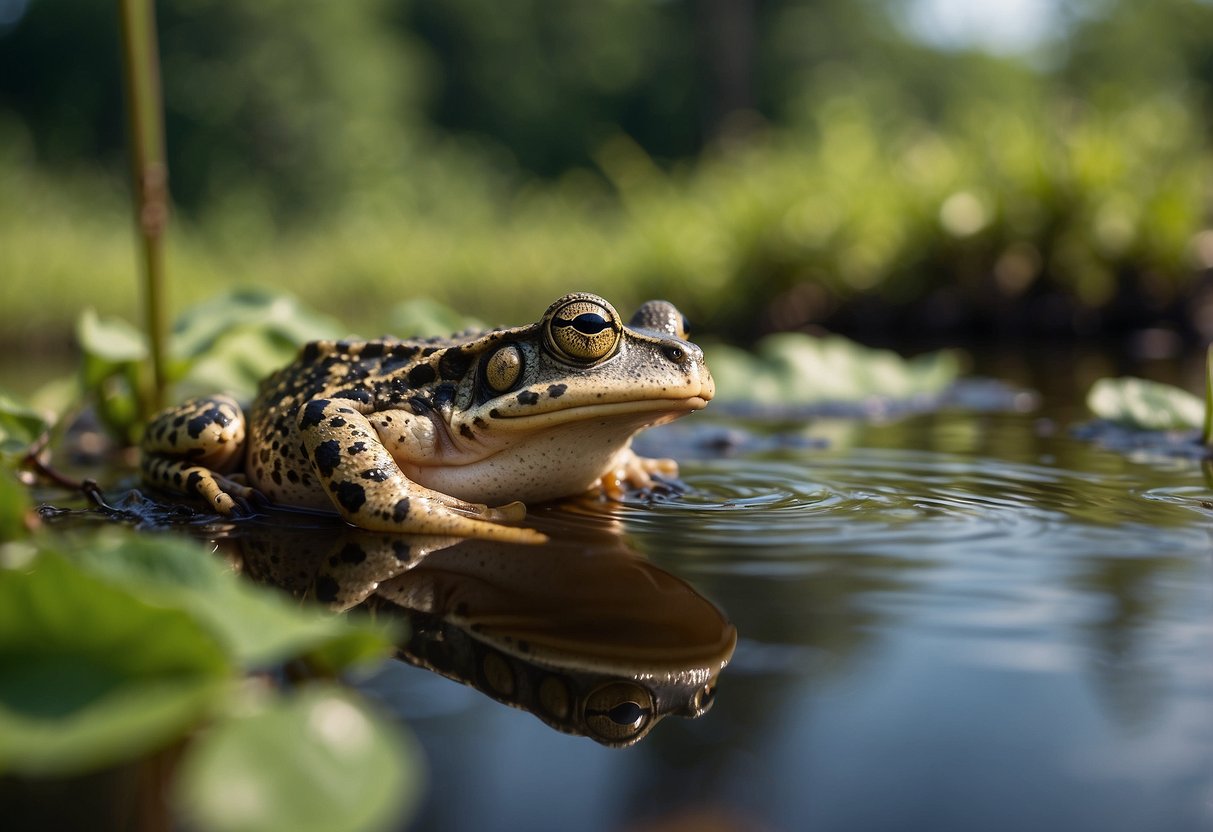
A frog-friendly habitat needs three key elements: water for breeding, shelter for protection, and safe spots for winter. I’ll explain how to set up each of these in your yard or garden.
Water Features for Breeding
Frogs and toads need clean, standing water to lay their eggs. I recommend adding a small pond or even a large birdbath. The water should be shallow at the edges, getting deeper towards the center. This lets tadpoles choose their ideal temperature.
To make a good breeding spot:
- Use native water plants for cover
- Avoid chemicals and pesticides
- Keep the water clean and fresh
Tadpoles of different species prefer different water depths. A mix of depths gives more frogs a chance to thrive.
If you’re worried about mosquitoes, add some mosquito fish. They eat the larvae but won’t harm your frogs.
Shelter and Hiding Spots
Frogs need places to hide from predators and the hot sun. I like to create varied shelter options.
Good shelter ideas include:
- Loose piles of rocks or logs
- Dense native plants
- Toad houses made from clay pots
Leave some areas of your yard a bit wild. Tall grass and leaf litter make great hiding spots for frogs.
I also add some flat rocks near the water. Frogs like to bask on these to warm up.
Safe Overwintering Sites
In colder areas, frogs need safe places to spend the winter. They often burrow into mud or leaves to stay warm.
To help frogs survive winter:
- Leave piles of leaves in sheltered spots
- Create deep areas in your pond that won’t freeze solid
- Add a compost heap – it provides warmth as it breaks down
Some frogs, like tree frogs, prefer to hibernate above ground. I leave some hollow logs or deep tree bark for them.
Don’t clean up your whole yard in fall. Those messy spots are perfect for sleepy frogs!
Impact of Climate and Seasonal Changes
Climate and seasons affect frogs and toads greatly. I’ll explore how to adjust for temperature changes and manage water levels to keep these amphibians healthy year-round.
Adjusting for Temperature Variations
Frogs and toads are cold-blooded, so temperature impacts their activity levels. I need to provide areas with different temperatures.
In summer, I’ll create shaded spots and shallow water areas for cooling. For winter, I’ll add deeper pools that don’t freeze solid.
Warmer climates can speed up aging in frogs and toads. I’ll monitor temperatures closely and take action if they get too high. Adding misters or sprinklers can help cool the habitat on hot days.
I’ll also create hibernation spots for winter. These can be leaf piles, logs, or underground burrows. They need to stay above freezing but cool enough for proper hibernation.
Managing Water Levels
Water is crucial for frogs and toads. I’ll maintain different water depths year-round.
Shallow areas are great for breeding and tadpoles. Deeper spots provide safety from predators and help regulate temperature.
In dry seasons, I’ll add water to keep levels steady. During rainy periods, I’ll ensure proper drainage to prevent flooding. A rain gauge helps me track precipitation.
I’ll use clean, dechlorinated water when filling ponds or pools. Tap water can harm amphibians. Rain barrels are a good way to collect natural water for the habitat.
Conservation Strategies
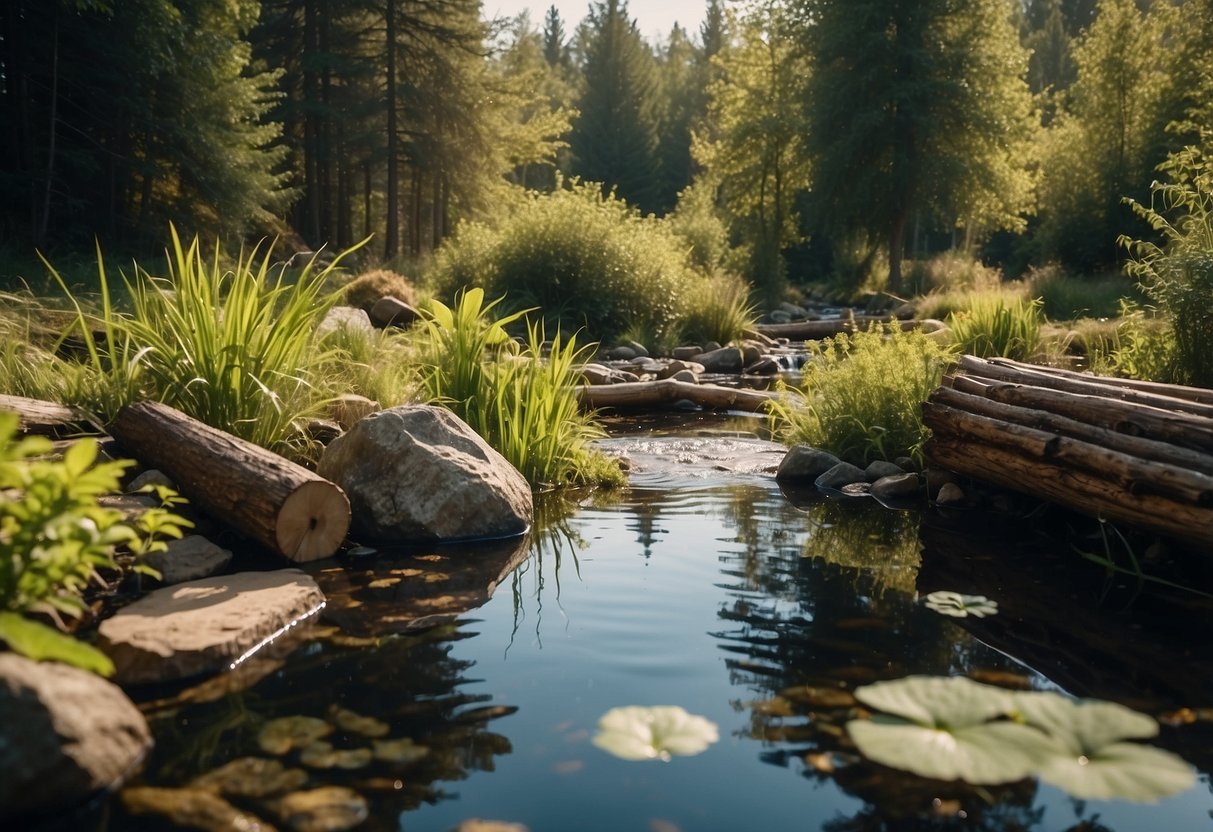
To maintain healthy frog and toad populations, we need to focus on protecting their habitats and promoting diverse ecosystems. I’ll cover two key approaches that can make a big difference.
Protecting Local Ecosystems
I recommend creating frog-friendly backyards as a starting point. This means avoiding chemicals and pesticides that can harm amphibians.
I also suggest setting up small ponds or water features. Even a simple birdbath at ground level can help. These provide crucial breeding spots for frogs and toads.
Preserving natural vegetation around water sources is vital. It gives frogs shelter and places to hunt. I advise leaving some areas of your yard a bit wild and untidy.
Reducing light pollution at night can also help. Many frogs are nocturnal, so bright lights can disrupt their behavior.
Fostering Biodiversity
I find that supporting local conservation efforts is key to fostering biodiversity. This might involve joining citizen science programs to monitor frog populations.
Creating diverse habitats is crucial. I suggest planting a variety of native plants to attract insects – a key food source for frogs.
Leaving some fallen logs and leaf litter in your yard provides shelter for frogs. These also attract insects for frogs to eat.
I recommend setting up rainwater collection systems. This provides a clean water source for frogs and helps maintain moist environments they need.
Natural Predators and Threat Management
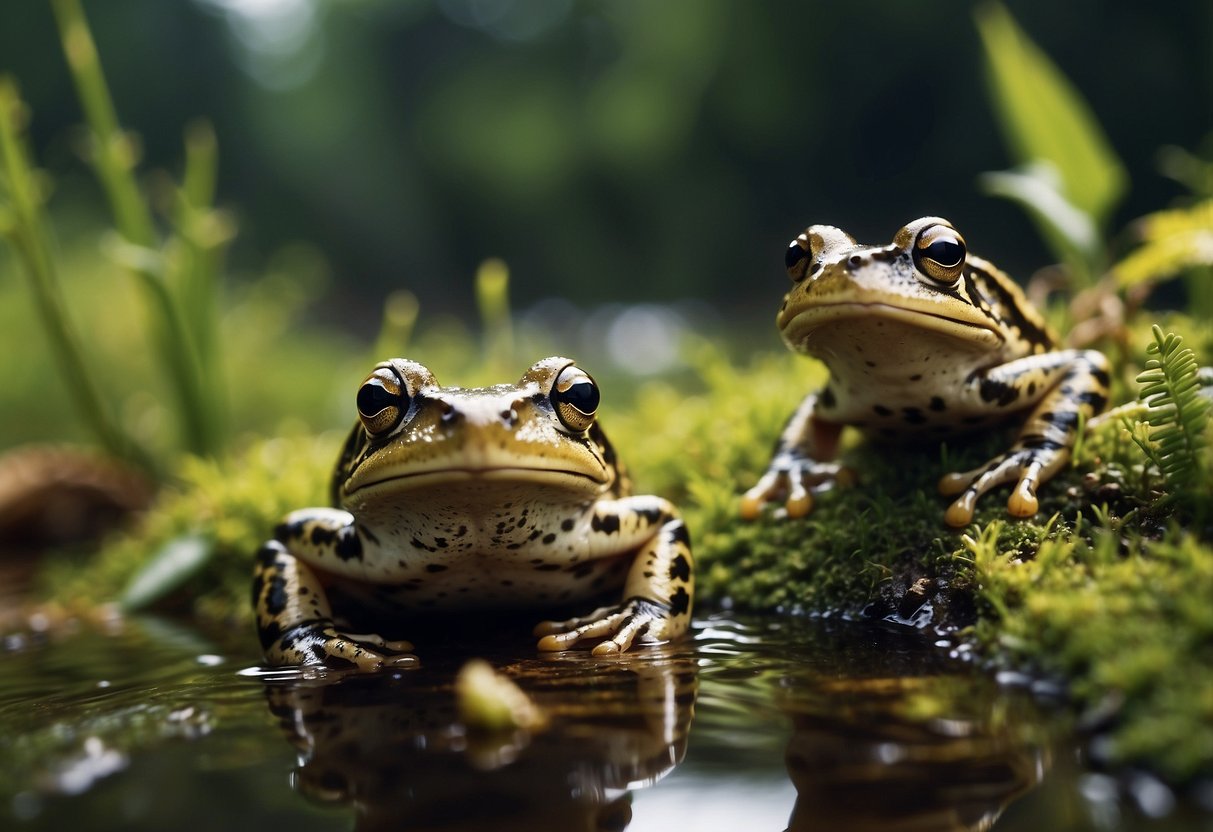
Keeping frogs and toads safe from predators and diseases is key to maintaining a healthy population. I’ll cover some effective ways to deter common predators and prevent illnesses that can harm amphibians.
Predator Deterrence
To protect frogs and toads from predators, I need to focus on creating safe habitats.
Snakes are top predators of toads, so I’ll install barriers like fine mesh fencing around ponds and gardens. This keeps snakes out while allowing smaller creatures to pass through.
I can also add plenty of hiding spots. Rocks, logs, and dense vegetation give frogs and toads places to escape from birds and mammals. Water features with varying depths are helpful too. Deeper areas let amphibians dive away from aerial predators.
Motion-activated lights and sprinklers can startle nocturnal predators like raccoons. For a natural approach, I might plant mint or scatter citrus peels around key areas. The strong scents repel some predators without harming the amphibians.
Disease Prevention
To prevent diseases in frog and toad populations, I need to maintain clean habitats. Regular water changes in ponds and careful filtering help remove harmful bacteria and parasites. I’ll also avoid using chemicals that could weaken amphibian immune systems.
Quarantining new amphibians before introducing them to established populations is crucial. This stops the spread of infections. I’ll also regularly inspect frogs and toads for signs of illness like discolored skin or unusual behavior.
Proper nutrition boosts immunity. I’ll ensure a varied diet of insects and small invertebrates. Supplementing with calcium and vitamins can help, especially for captive populations. Maintaining ideal temperature and humidity levels in habitats also keeps amphibians healthy and resistant to disease.
Supplemental Feeding and Care
Keeping frogs and toads healthy requires proper nutrition and regular check-ups. I’ll cover key supplements and health monitoring practices to maintain a thriving amphibian population.
Appropriate Food Supplements
Frogs and toads need specific nutrients to stay healthy in captivity. I recommend dusting their food with calcium powder 2-3 times per week. This helps prevent metabolic bone disease.
Vitamin supplements are also crucial. I use a reptile multivitamin once a week to ensure they get enough vitamin A and D3. These support eye health and calcium absorption.
For aquatic species, I add liquid vitamins to their water. This helps them absorb nutrients through their skin.
Leafy greens like spinach and kale are great sources of vitamins A and C. I offer these to omnivorous species as part of a varied diet.
Regular Health Checks
I perform visual inspections of my frogs and toads daily. I look for signs of illness like lethargy, loss of appetite, or skin changes.
Weighing them monthly helps me track their health over time. Sudden weight loss can indicate problems.
I also check their enclosure conditions regularly. Proper temperature, humidity, and water quality are vital for preventing illness.
If I notice any issues, I consult a vet experienced with amphibians. Early intervention is key for treating health problems in frogs and toads.
I also quarantine new arrivals for at least 30 days before introducing them to my existing population. This prevents the spread of potential diseases.
Community Engagement and Education
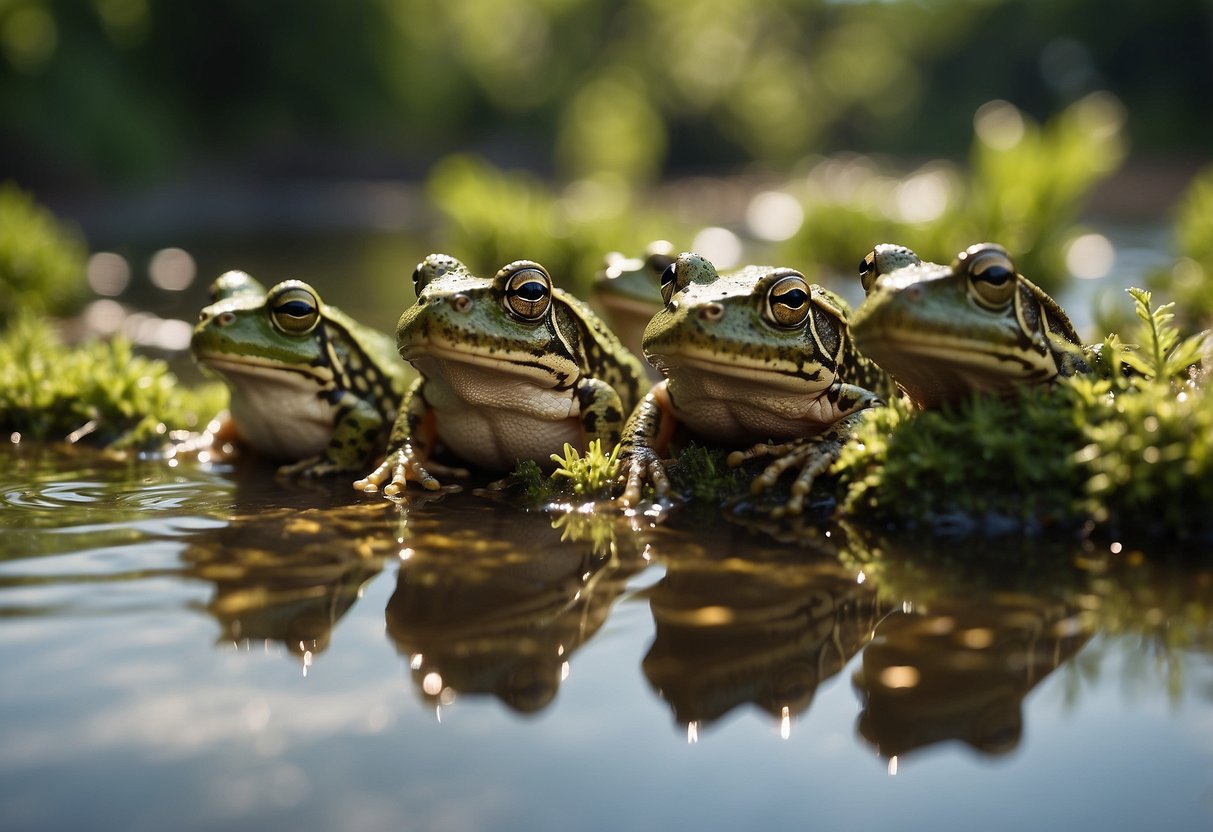
Getting others involved is key to protecting frogs and toads. I’ll share ways to spread the word and get people excited about helping these animals.
Promoting Awareness
I can organize local events to teach people about frogs and toads. Frog walks at night are fun and let folks see and hear these animals up close.
I’ll set up booths at community fairs with info and photos. Kids love seeing tadpoles grow, so I can bring some to schools.
Making simple flyers about local amphibian species and how to help them is useful. I’ll post these at parks, libraries, and nature centers.
Social media is great for sharing frog facts and photos. I can start a local frog-watching group on Facebook or Instagram.
Teaming up with scout troops or garden clubs helps reach more people. We can do projects like building frog ponds or making toad houses.
Monitoring and Data Collection
Keeping track of frog and toad populations is key to maintaining their health. I’ll explain how to monitor these amphibians and use the data to help them thrive.
Tracking Population Health
I start by listening for frog calls on spring evenings. This tells me which species are present and how many there are. I note down what I hear and where.
I also do visual surveys, looking for frogs and tadpoles in ponds and wetlands. I count how many I see of each species and life stage.
I take photos to document any unusual findings or changes over time. This visual record is very helpful.
I make sure to wash my hands and gear between sites to avoid spreading diseases.
Using Data for Continuous Improvement
I enter my observations into a citizen science database. This helps researchers track frog populations on a larger scale.
I compare my data year to year to spot trends. If I notice declines, I look for possible causes like habitat changes or new predators.
I use the data to guide habitat improvements. For example, if I see fewer tadpoles, I might add more shallow areas to my pond.
I also share my findings with local nature groups. This raises awareness and gets more people involved in frog conservation.
Legal Protections and Compliance
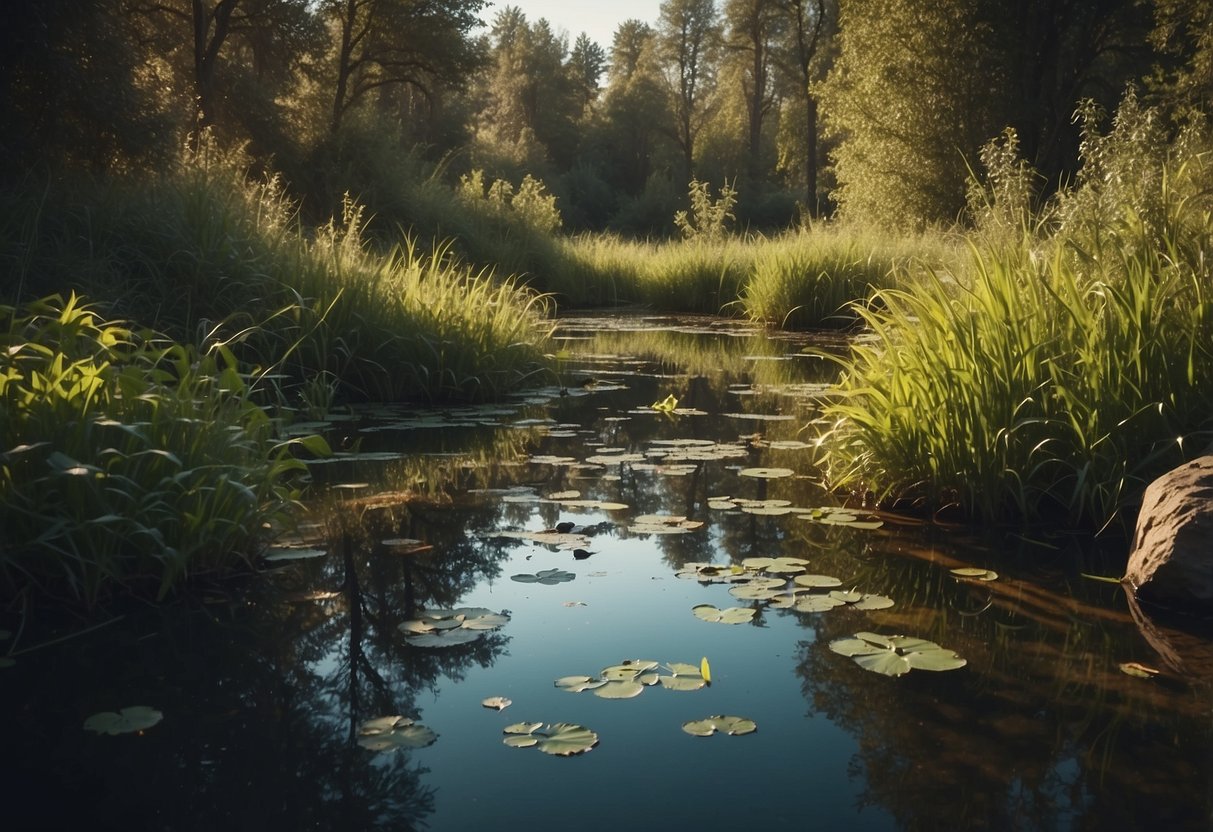
Many frog and toad species are protected by law. I need to be aware of local, state, and federal regulations before taking any actions that might affect them.
In the US, the Endangered Species Act safeguards threatened amphibians. I should check if any species in my area are listed as endangered or threatened.
It’s illegal to collect or harm protected frogs and toads. I must leave them alone in their natural habitats.
Some areas have rules about altering wetlands or water features where amphibians live. I should get proper permits before making changes to ponds or streams on my property.
Using certain pesticides may be restricted near frog habitats. I need to follow all label instructions and local regulations when applying chemicals.
If I suspect a frog disease outbreak, I should report it to wildlife authorities. They can investigate and take steps to protect populations.
Long-Term Sustainability Planning
To keep frogs and toads thriving in my area, I need a solid plan. I’ll focus on creating habitats that last for years to come.
First, I’ll make sure there’s always clean water. I can set up a small pond or wetland area that stays full year-round. This gives frogs a place to lay eggs and grow.
Next, I’ll plant native plants around the water. These give frogs places to hide and hunt for food. I’ll choose plants that don’t need much care so they last a long time.
I’ll also think about food sources. Frogs eat bugs, so I’ll avoid using pesticides. This keeps their food supply steady.
To track how well I’m doing, I can count frogs each year. If I see numbers going down, I’ll need to change my plan.
It’s key to harvest frogs carefully if I choose to do so. Taking only 5-10% of the population per year can help keep numbers stable.
Frogs are great at showing how healthy an area is. If they’re doing well, it means my whole ecosystem is likely in good shape.
Frequently Asked Questions
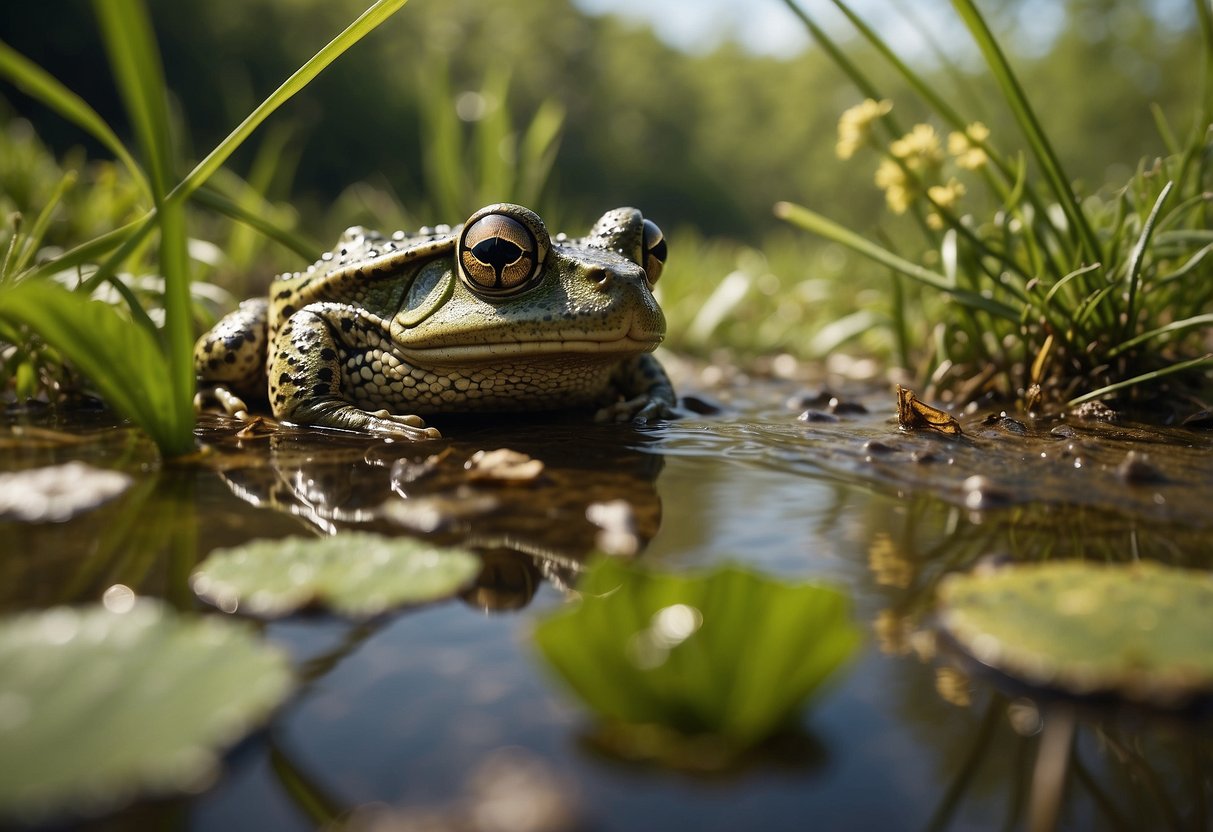
Maintaining a healthy frog and toad population requires creating the right habitat and taking steps to support their wellbeing. Here are some common questions about fostering these amphibians in your garden.
What are the ideal conditions to encourage a thriving frog and toad population in my garden?
Frogs and toads need a mix of wet and dry areas. I recommend creating a small pond or water feature with shallow edges. Add native plants around the water for shelter and food sources.
Avoid using chemicals in your garden. Provide hiding spots like logs, rocks, and leaf piles. Keep some areas of your lawn unmowed for natural cover.
How can I create a sustainable habitat for frogs and toads if I don’t have a pond?
Even without a pond, I can create frog-friendly spaces. I’ll add a shallow birdbath at ground level for moisture. I can also create a “toad abode” using an overturned clay pot with an entrance hole.
I’ll maintain damp areas by watering parts of the garden regularly. Mulching helps retain moisture too. Adding native plants attracts insects for food.
What are some effective ways to attract frogs and toads to my garden?
To attract frogs and toads, I’ll focus on their basic needs. I’ll provide clean water sources like shallow dishes or small ponds. I’ll plant native vegetation to create shelter and attract insect prey.
I’ll avoid using pesticides and create hiding spots with rocks, logs, and leaf litter. Leaving some areas of my lawn unmowed can also help.
What should I do if I find a frog in my garden to ensure its wellbeing?
If I find a frog, I’ll leave it alone unless it’s in danger. I won’t move it far from where I found it. I’ll ensure there’s a water source nearby.
I’ll avoid handling frogs with bare hands, as oils from my skin can harm them. If I must move one, I’ll use clean, wet hands or a container.
Can having a garden population of frogs and toads be beneficial or detrimental to my local ecosystem?
Native frogs and toads are beneficial for gardens and local ecosystems. They eat insects, helping to control pest populations naturally. Their presence indicates a healthy environment.
Frogs also serve as food for other wildlife, contributing to biodiversity. They don’t cause harm to garden plants or other beneficial species.
What measures can I take to support the health and sustainability of the local frog population?
To support local frogs, I’ll create diverse habitats in my garden. I’ll maintain clean water sources and avoid using chemicals.
I’ll plant native species to provide food and shelter.
I can also participate in local frog monitoring programs. I’ll be careful not to introduce non-native species, which can harm local populations.
